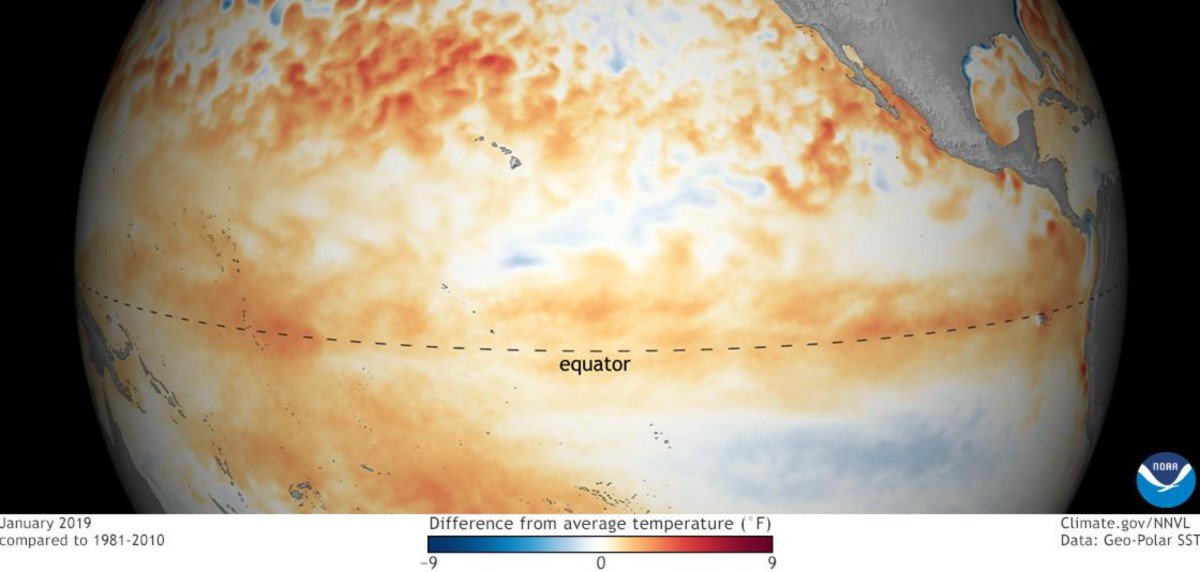El Nino? Depends on who you ask.

According to the US National Weather Service, El Nino has developed in the Pacific Ocean and is expected to continue during the next three months.
However, Australia's Bureau of Meteorology claims that the Pacific Ocean is currently in a neutral phase and El Nino only has a 50 per cent chance of developing during the coming months.
This conflicting information is bound to cause some confusion. So, what's going on?
Australia and America use different thresholds to define El Nino and La Nina events. As you may have guessed, Australia's thresholds are a little higher than our northern hemisphere counterparts.
El Nino occurs when warmer than usual water develops near the equator in the central and eastern Pacific Ocean, while cooler water sits to the northeast of Australia. This pattern causes trade winds over the Pacific Ocean, which usually transport moisture towards Australia, to weaken and sometimes reverse. El Nino events often cause below average rain in parts of Australia because of this disruption to the moisture-transporting trade winds.
For an El Nino event to be declared by Australia's Bureau of Meteorology, any three of the following four thresholds need to be met:
- Sea surface temperatures in the central and eastern equatorial Pacific Ocean (NINO3 or NINO3.4 regions) are 0.8C warmer than average.
- Trade winds have been weaker than average in the western or central equatorial Pacific Ocean during any three of the last four months.
- The three-month Southern Oscillation Index (a measure of the mean sea level pressure difference between Tahiti and Darwin) is -7 or lower.
- A majority of surveyed climate models show sustained warming to at least 0.8C above average in the NINO3 or NINO3.4 regions of the Pacific until the end of the year.
America's thresholds of El Nino are lower than Australia's and lean more heavily on what's expected to happen in the future. The U.S. Climate Prediction Centre (CPC) recognises that El Nino conditions are observed when:
- Sea surface temperatures in the eastern equatorial Pacific (NINO3.4 region) are 0.5C warmer than usual, averaged over one month.
- There is an expectation that the sea surface temperature in the NINO-3.4 region will stay above 0.5C above average for at least three consecutive months.
- The atmosphere is expected to respond to this ocean warming, meaning a weakening of the trade winds that usually transport moisture towards Australia.

Image: Pacific Ocean sea surface temperature anomalies during Janaury 2019. Source: NOAA
Australia's thresholds for El Nino are far from being exceeded at the moment. However, there is just enough warming in the central and eastern Pacific Ocean, and signs that the atmosphere is responding to this warming, for America's National Weather Service to declare that El Nino is underway.
Despite the inconsistent terminology between these two organisations, most of us really just want to know what this might mean in terms of weather during the next few months.
One point of agreement between Australia and America is that any El Nino event during the coming months would likely be quite weak. The U.S. Climate Prediction Centre points out that:
"Due to the expected weak strength [of El Nino], widespread or significant global impacts are not anticipated. However, the impacts often associated with El Nino may occur in some locations during the next few months."
There's no doubting that the Pacific Ocean is in an El Nino-like pattern, and this could influence Australian rainfall during the coming months. According to the Bureau of Meteorology's latest seasonal outlook:
"The autumn (March to May) climate outlook, issued 14 February 2019, indicates a drier than average season is likely for large parts of northern Australia. The rest of the country shows no strong tendency towards a wetter or drier than average autumn."
You can visit http://www.bom.gov.au/climate/enso/ to find the latest information on El Nino from Australia's Bureau of Meteorology.